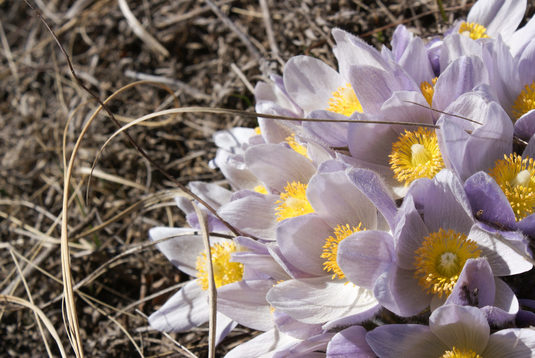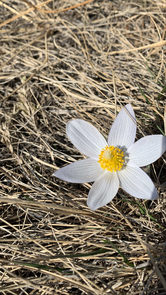Today’s featured prairie plant is Anemone patens also known as Prairie Crocus, Crocus Anemone, Pasque Flower or Prairie Smoke. It is best known for being the first flower to bloom following winter, often before complete snowmelt has occurred, signalling the start of spring on the prairies. This long-lived perennial flower is native to Canada and grows on open prairies, along hillsides, roadsides, dry grasslands and open woods. This versatile plant is adapted to grow in well-drained, sandy soils with low nutrient content and in locations that receive lots of sunlight. It is also known to grow in areas that have been disturbed or in areas where the topsoil had been removed.
Prairie Crocus boasts large pale blue to purple, saucer-shaped, petals with fuzzy, yellow stamens in the centre. Their beautiful mauve-coloured petals of the flower bloom early as a strategy to avoid growing and competing with other summer flowers, also avoiding the extreme summer heat, by having its seeds ripening and germinating early before going dormant for the winter, by mid-July.

Photo by Alyssa Vibert - Saskatoon, Saskatchewan
Prairie Smoke, when growing in abundance, is often indicative of an over-grazed landscape. Despite its use as an indicator species for environmental conditions, the pasqueflower is not beneficial to wildlife as a food source. The tiny hairs on the plant are known to cause gastrointestinal irritation in livestock and have no nutritional value for wildlife with their low palatability and mild toxicity.
While not of use to wildlife, Prairie Crocus is very important to Indigenous communities for its importance in traditional medicine. Its leaves, when fresh, have been used for relief in cases of rheumatism and neuralgia, and when crushed have been used for poultices. The crushed leaves have also been used to ease headaches and liquid extracted for use with pulmonary complications.
Did you know:
The saucer shape of the Prairie Crocus’ petals, paired with the shininess of its petals, creates a reflection that causes energy to bounce between the stamens and pistils of the flower, warming the inside of the flower up to 10 degrees warmer than the temperature of its environment!

Single Prairie Crocus by Alyssa Vibert - Saskatoon, Saskatchewan
Resources:
Scientific Name: Rosa acicularis Lindl (ualberta.ca)
Biology of the Prairie Crocus (Anemone patens) (naturenorth.com)

